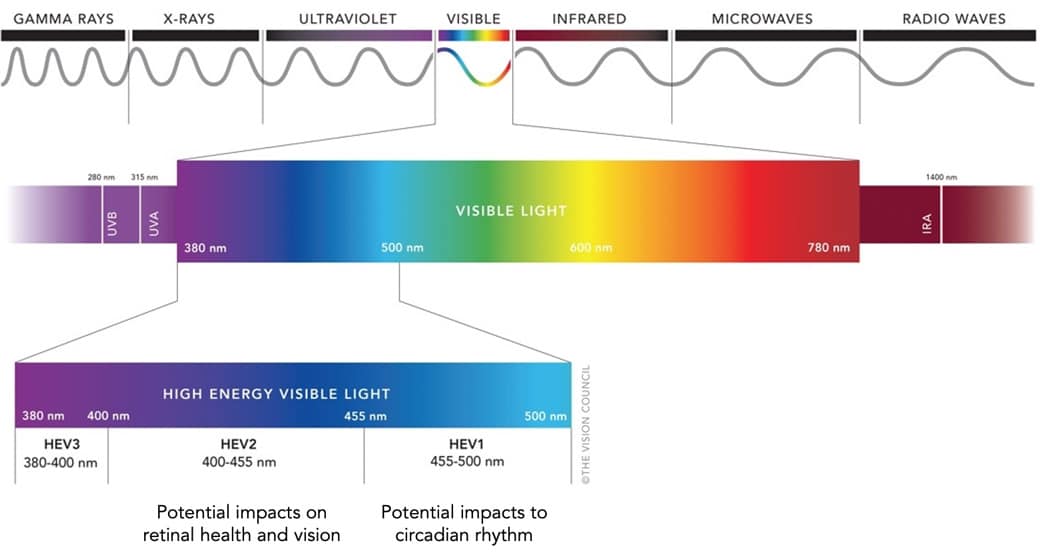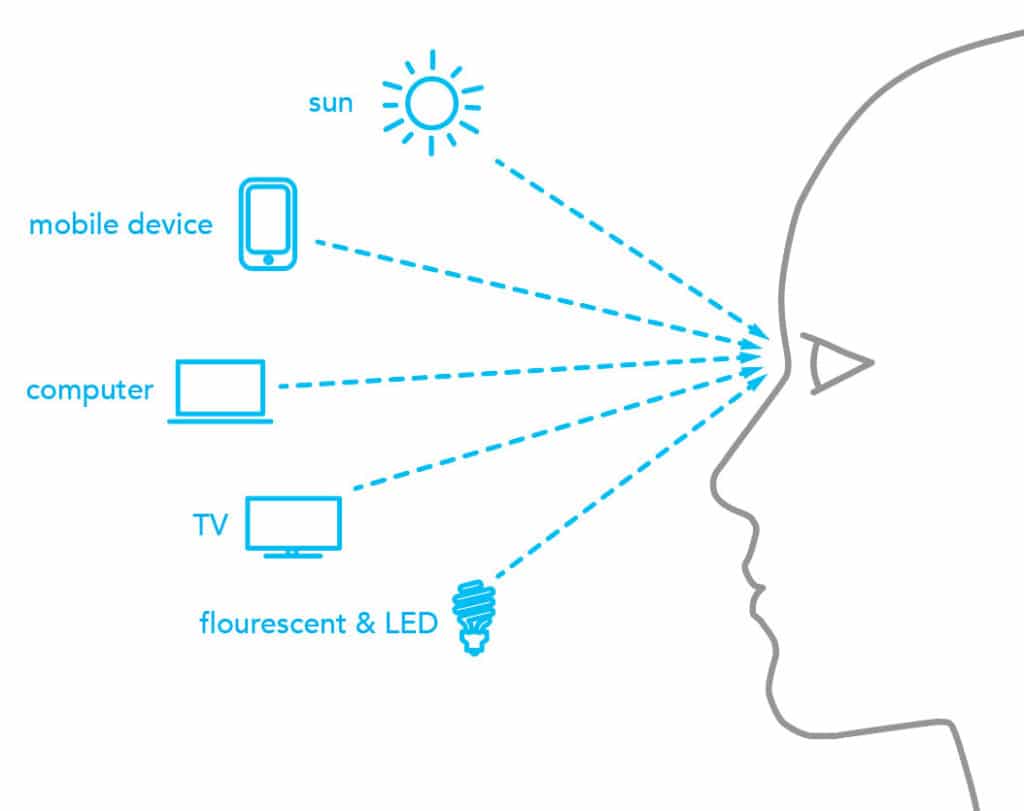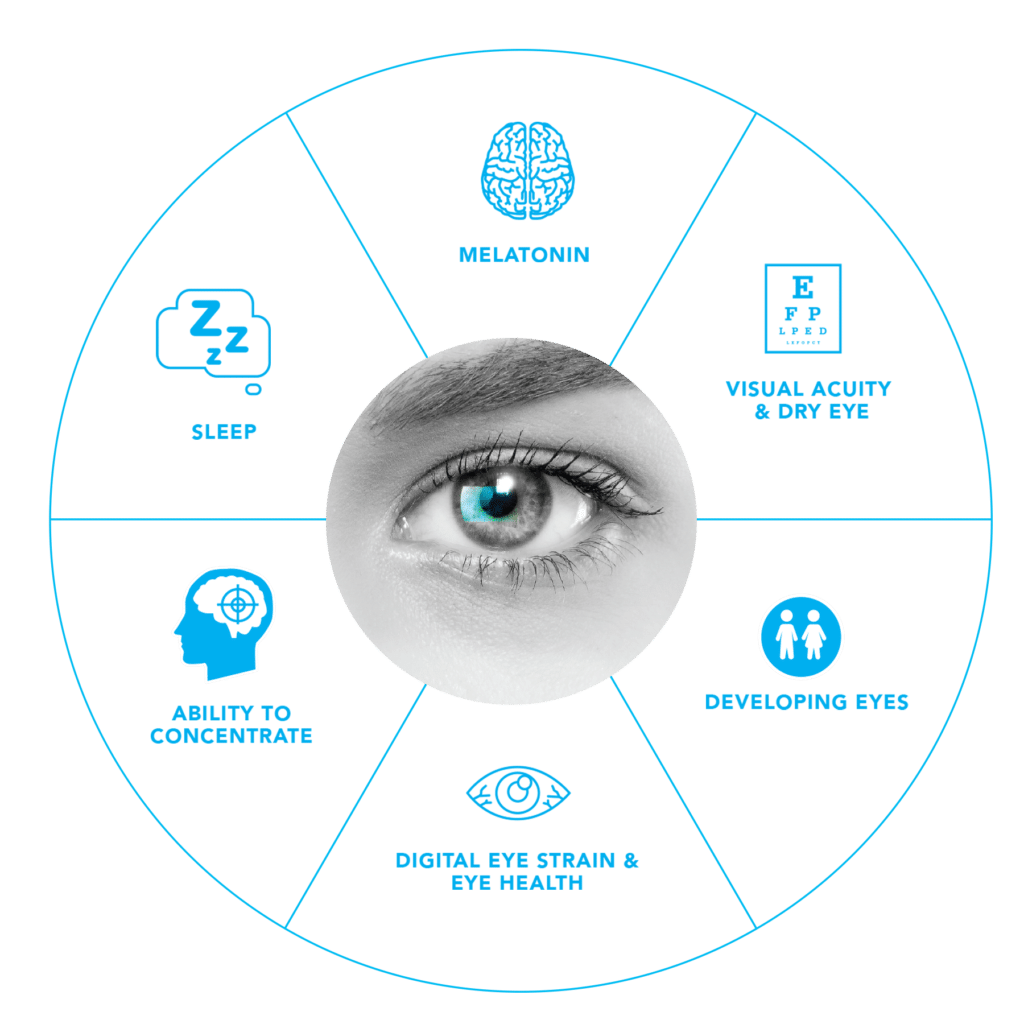What is Blue Light?
Blue light, also known as high-energy visible (HEV) light, is a color in the visible light spectrum that can be seen by human eyes. These wavelengths of visible and non-visible light are measured in nanometers (nm), and, in general, the shorter the wavelength, the higher the energy. Blue light is a short wavelength, which means it produces higher amounts of energy.
Unlike other forms of light, the eyes cannot effectively filter blue light, so more can pass through the eye to the retina. Blue light produces both benefits and concerns for our eyes and overall health.
Sources of High-Energy Blue Light
We are exposed to blue light on a near constant basis. The largest source of blue light is sunlight, but is also emitted by laptops and computer monitors, smartphones, tablets, TV, fluorescent and CFL bulbs.
Our blue light exposure from digital devices are of particular concern because of the close proximity of the screens, length of time we use our devices, and the cumulative impact of using devices every day.
The Blue Light Spike
There are some key differences between natural sources of blue light, like daylight, and artificial sources, such as the LEDs used in digital devices.
Most of the light from the LEDs has wavelengths between 400 and 490 nanometers. Many LED screens peak in the 435-440 nm. This range is connected significant concern in medical research.1

What are the Benefits of Blue Light?
Moderate amounts of blue light is essential for good health.2
- Promotes alertness
- Boosts memory and cognitive function
- Elevates mood
- Regulates circadian rhythm
What are the Risks?
Eyes and Body
Screen time has been on the rise for the last 20 years and is now exceeding 13 hours per day.1 According to the Vision Council, many people experience eye discomfort and vision problems when using digital devices for extended periods.
As many as 65% of Americans report experiencing symptoms of digital eye strain, which may include symptoms of:3
- Eye strain
- Blurred vision
- Dry, irritated eyes
- Headaches
Sleep
The use of digital devices at night may suppress the release of melatonin, the hormone responsible for making us feel drowsy. Too much blue light exposure from viewing screens at night may result in:4
- Impact to our circadian rhythms
- Trouble sleeping
- Waking up during the night
- Reduced alertness the next day
Long-Term
There is evidence that the eye is susceptible to blue light exposure, and that over a period of time, cumulative exposure may increase the likelihood of vision problems. More research is needed to ascertain long-term impacts to the retina and any links to chronic vision problems.1
Children
Children may be more vulnerable because their eyes don’t have the same blue light-filtering ability that adult eyes have. Children also tend to hold devices closer to their eyes, increasing the intensity of high-energy visible blue light reaching their eyes.2
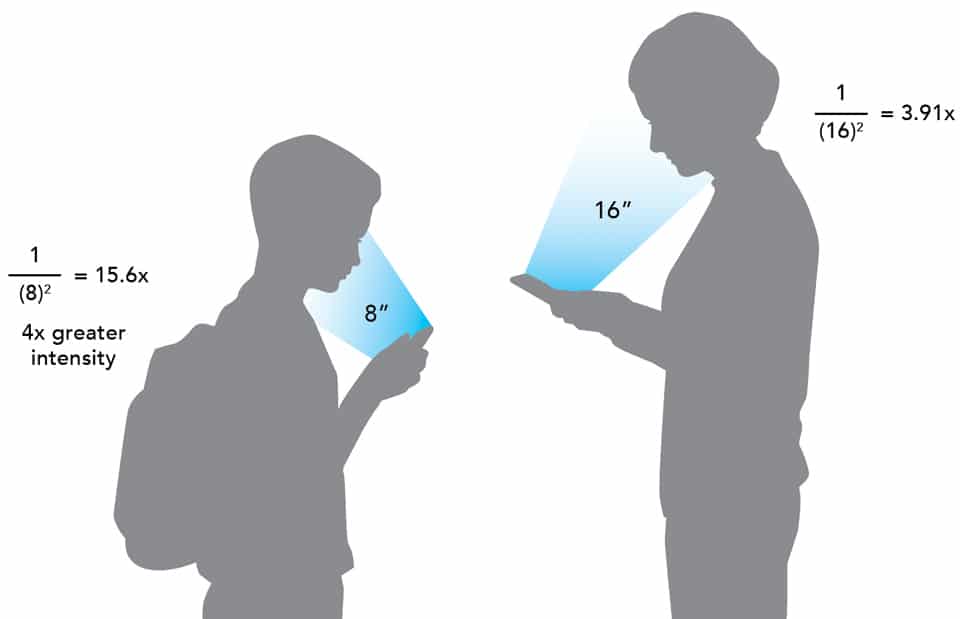

Concerns about Blue Light
Screen time and blue light exposure have been raised as a growing public health concern. Doctors, educators, employers and parents agree that there are potential risks from overexposure. According to a recent survey, doctors believe the following are symptoms of excessive screen time and blue light exposure:6
- Sleep disruption (79%)
- Tired/ sore eyes (77%)
- Dry eyes (70%)
- Headaches (56%)
- Reduced productivity (46%)
- Reduced concentration (43%)
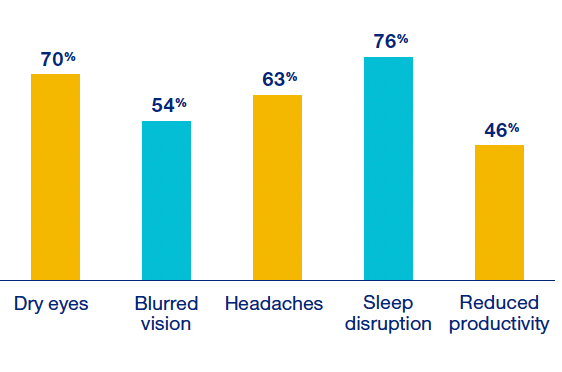
Reducing Exposure
Blue light cannot be completely avoided, but there are ways to limit exposure. They include:
1. Eye Exam: Talk to an eye care professional about options about ways to protect your family and your eyes from blue light.
2. Screen Time: Try to decrease the amount of time spent in front of these screens.
3. Screen Protectors: Screen Protectors with advanced blue light filtration are available for smartphones, tablets, laptops and computer monitors.
4. Built-In Technology: Many laptops and monitors now have technology designed into the hardware, which helps reduce blue light emissions.
5. Follow the 20-20-20 Rule: For every 20 minutes spent looking at a screen, a person should look at something 20 feet away for 20 seconds.
6. Anti-Reflective Lenses: Anti-reflective lenses reduce glare and increase contrast and may also help reduce blue light from the sun and digital devices.
7. Use Device Software: Try setting your devices to night mode which adjusts the screen display to a warmer temperature, the downside is your screen will have a yellow or amber tint.
8. Computer Glasses: Computer glasses with yellow-tinted lenses often reduce blue and increase contrast, but similar to night mode software, the user has to compromise on color.
Ask a Doctor: What is Blue Light?
“The eyes are not good at filtering out blue light. Blue light screen protectors reduce light at the source to help protect you from potential blue light risks.”
1. Consolidated Blue Light Research, available at eyesafe.com/research
2. Blue light has a dark side – Harvard Health
3. Digital Eye Strain, The Vision Council
4. Chang AM, et al. Evening use of light-emitting eReaders negatively affects sleep, circadian timing, and next-morning alertness. Proceedings of the National Academy of Sciences of the United States (PNAS). January 2015. 112(4): 1232-1237. [Accessed December 3, 2019]
5. Behar-Cohen F, et al. Light-emitting diodes (LED) for domestic lighting: any risks for the eye? Progress in Retinal and Eye Research. 2011 Jul;30(4):239-57.)
6. 2020 UnitedHealthcare and Eyesafe Screen Time Survey of 400 Eye Care Professionals
7. 2022 UnitedHealthcare and Eyesafe Screen Time Survey of 484 Parents and 408 Educators
Learn more about Eyesafe® Solutions to reduce blue light emissions from digital devices:
